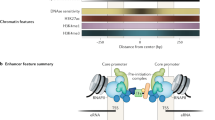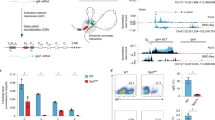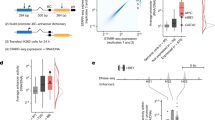Abstract
Enhancers are eukaryotic promoter elements that increase tran-scriptional efficiency in a manner relatively independent of their position and orientation with respect to a nearby gene1–3. There is growing evidence that enhancer action is mediated by transacting factors4–8, but the mode of action of these factors is not yet known. We report here on the Xenopus U2 gene promoter, which contains two sequence elements. The distal sequence element increases promoter activity 20-fold by facilitating the formation of stable transcription complexes. A synthetic 14-base-pair (bp) oligonucleotide corresponding to part of the distal sequence element, which shows homology to an immunoglobulin gene promoter element and to both the simian virus 40 (SV40) and the immunoglobulin heavy-chain gene enhancers, stimulates transcription in an orientation-independent manner.
This is a preview of subscription content, access via your institution
Access options
Subscribe to this journal
Receive 51 print issues and online access
$199.00 per year
only $3.90 per issue
Buy this article
- Purchase on Springer Link
- Instant access to full article PDF
Prices may be subject to local taxes which are calculated during checkout
Similar content being viewed by others
References
Banerji, J., Rusconi, S. & Schaffner, W. Cell 27, 299–308 (1981).
Moreau, P., Hen, R., Wasylyk, B., Everett, R., Gaub, M. P. & Chambon, P. Nucleic Acids Res. 9, 6047–6068 (1981).
Cereghini, S. et al. Cold Spring Harb. Symp. quant. Biol. 47, 935–944 (1982).
Banerji, J., Olson, L. & Schaffner, W. Cell 33, 729–740 (1983).
Gillies, S. D., Morrison, S. L., Oi, V. T. & Tonegawa, S. Cell 33, 717–728 (1983).
Borrelli, E., Hen, R. & Chambon, P. Nature 312, 608–612 (1984).
Wildemann, A. G., Sassone-Corsi, P., Grundström, T., Zenke, M. & Chambon, P. EMBO J. 3, 3129–3133 (1984).
Ephrussi, A., Church, G. M., Tonegawa, S. & Gilbert, W. Science 227, 134–140 (1985).
Ares, M. Jr, Mangin, M. & Weiner, A. M. Molec. cell Biol. (in the press).
Mattaj, I. W. & Zeller, R. EMBO J. 2, 1883–1891 (1983).
Roop, D. R., Kristo, P., Stumph, W. E., Tsai, M. J. & O'Malley, B. W. Cell 23, 671–680 (1981).
Murphy, J. T., Burgess, R. R., Dahlberg, J. E. & Lund, E. Cell 29, 265–274 (1982).
Zeller, R., Carri, M.-T., Mattaj, I. W. & De Robertis, E. M. EMBO J. 3, 1075–1081 (1984).
Mattaj, I. W. Trends biochem. Sci. 9, 435–437 (1984).
Skuzeski, J. et al. J. biol. Chem. 259, 8345–8353 (1984).
Westin, G., Lund, E., Murphy, J. T., Pettersson, U. & Dahlberg, J. E. EMBO J. 3, 3295–3301 (1984).
Bogenhagen, D. F., Wormington, W. M. & Brown, D. D. Cell 28, 413–421 (1982).
Brown, D. D. Cell 37, 359–365 (1984).
Reeder, R. H., Roan, J. G. & Dunaway, M. Cell 35, 449–456.
Parslow, T. G., Blair, D. L., Murphy, W. J. & Granner, D. K. Proc. natn. Acad. Sci. U.S.A. 81, 2650–2654 (1984).
Falkner, F. G. & Zachau, H. G. Nature 310, 71–74 (1984).
Gruss, P., Dhar, R. and Khoury, G. Proc. natn. Acad. Sci. U.S.A. 78, 943–947 (1981).
Krol, A., Lund, E. & Dahlberg, J. EMBO J. (in the press).
Ciliberto, G., Buckland, R., Cortese, R. & Philipson, L. EMBO J. (in the press).
Labhart, P. & Reeder, R. H. Cell 37, 285–289 (1984).
Grosschedl, R. & Birnstiel, M. L. Proc. natn. Acad. Sci. U.S.A. 77, 7102–7106 (1980).
Tani, T., Watanabe-Nagasu, N., Okada, N. & Oshima, Y. J. molec. Biol 168, 579–584 (1983).
Messing, J. & Vieira, J. Gene 19, 269–276 (1982).
Mattaj, I. W. & De Robertis, E. M. Cell 40, 111–118 (1985).
Mattaj, I. W. et al. in The Oxford Surveys on Eukaryotic Genes (Oxford University Press, in the press).
Author information
Authors and Affiliations
Rights and permissions
About this article
Cite this article
Mattaj, I., Lienhard, S., Jiricny, J. et al. An enhancer-like sequence within the Xenopus U2 gene promoter facilitates the formation of stable transcription complexes. Nature 316, 163–167 (1985). https://doi.org/10.1038/316163a0
Received:
Accepted:
Issue Date:
DOI: https://doi.org/10.1038/316163a0
This article is cited by
-
UsnRNP biogenesis: mechanisms and regulation
Chromosoma (2017)
-
A hit-and-run mechanism for transcriptional activation?
Nature (1988)
-
A cloned octamer transcription factor stimulates transcription from lymphoid–specific promoters in non–B cells
Nature (1988)
-
A transcription factor which binds to the enhancers of SV40, immunoglobulin heavy chain and U2 snRNA genes
Nature (1987)
Comments
By submitting a comment you agree to abide by our Terms and Community Guidelines. If you find something abusive or that does not comply with our terms or guidelines please flag it as inappropriate.



